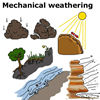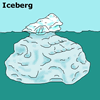
Water is a vital part of our world. It can exist in three forms - solid
(ice), liquid (water) and gas (steam). The effects of forces in all three
forms are very evident in everyday situations. In this unit the force
of ice is examined.
Ice
When water freezes, a strange thing happens that has a major influence
on everyday life. When liquids freeze to a solid they usually contract,
that is they get smaller. In the case of water, the molecules arrange
themselves in such a way that ice at 0°C takes up MORE space than
the liquid at 0°C.

|
Water freezing |
If a plastic container of water is frozen, the ice expands and the plastic bulges outwards. If not enough space is provided, the container will split under the force of the expanding ice. If the container is glass, you know what would happen then! Yes, the force of the molecules rearranging themselves within the ice will crack the glass - an enormous force is exerted. A similar thing would happen with the water in your car radiator or with water pipes which freeze with serious results.
 In geology, water freezing in cracks in rocks expands the cracks
and can even split rocks. This is an important type of weathering in highland
areas where night and day temperatures vary above and below 0°C.
In geology, water freezing in cracks in rocks expands the cracks
and can even split rocks. This is an important type of weathering in highland
areas where night and day temperatures vary above and below 0°C.
Some plants are also affected by the force of freezing water. The cells contain water and, as the water freezes, it expands, breaking the cell walls. That's why some plants, such as tomatoes, cannot survive when the temperature goes below freezing. Other plants have more flexible cell walls and these are said to be frost hardy.

|
Cell freezing, cell contents expanding and cell wall breaking. |
Freeze drying
As has been discussed, water expands when it freezes and this can be destructive.
A process called freeze drying enables plants or animals to be preserved
without damage to the cell walls. In this process, the plant or animal
is cooled below freezing point, but in a low pressure vacuum so that water
molecules are removed from the cells before they can form ice in the cells
and do damage. Frozen vegetables are treated in a similar way, as is instant
coffee.
 Icebergs
Icebergs
Because water expands when it freezes, ice is less dense than liquid
water, so it floats. (In fact the density of ice is about 0.9168 compared
to 0.9998 for water at the same temperature). A spectacular example of
this is an iceberg. They are often very heavy and can do damage to ships
if they are hit.
The melting point of ice is lowered under pressure. This has an important application in ice skating. An ice skating blade has a very small surface area so the weight of the skater exerts a high pressure. This means that the ice melts under the blade, the skater glides on water, then the ice refreezes behind the skater as the pressure is reduced.
| Copyright owned by the State of Victoria (Department of Education and Early Childhood Development). Used with Permission. |